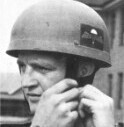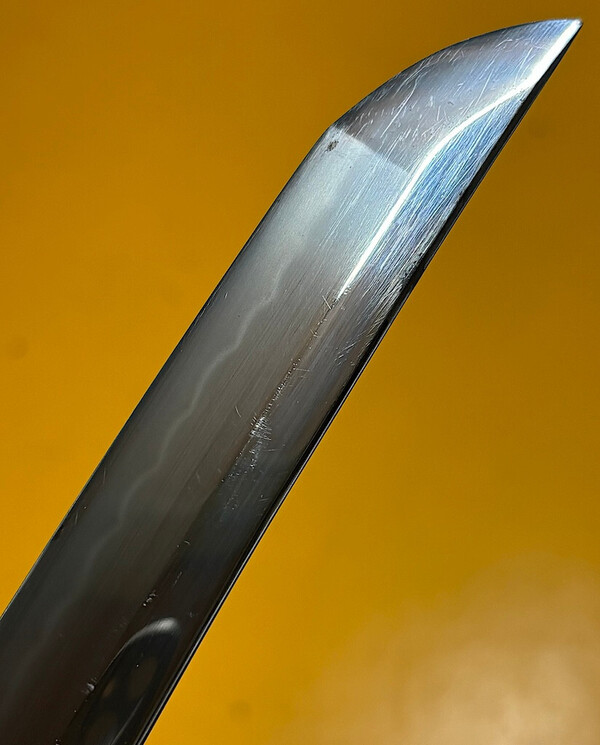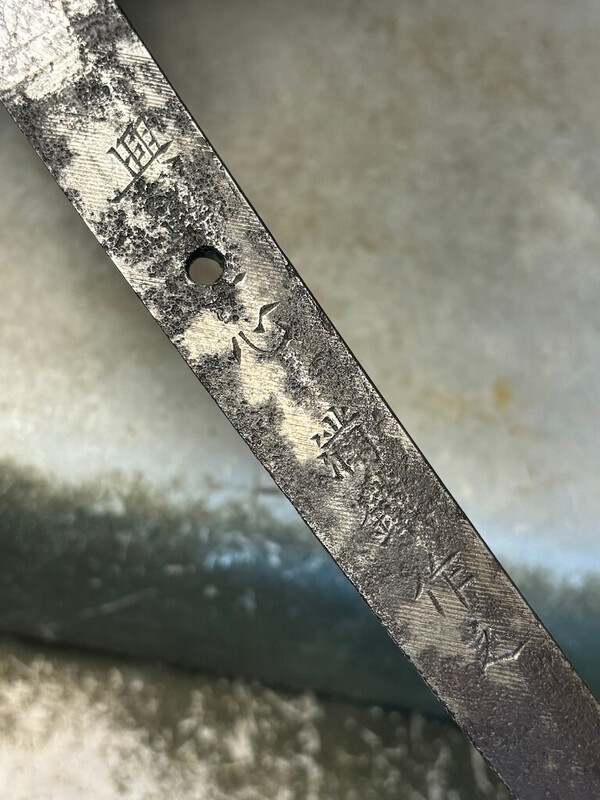-
Posts
89 -
Joined
-
Last visited
Content Type
Profiles
Forums
Events
Store
Downloads
Gallery
Everything posted by Fusilier
-
G'day, I recently purchased this gunto for resale. When I first saw it I thought the hamon was unusual and the blade was distinct from many I've seen in that appeared a bit more 'refined' if that is the right word. I was wondering whether its possible to determine the quality of the blade just by looking at images of the blade and the hamon or whether that is only possible if you can physically examine the sword. I've checked to see if there are any of the 'seki' like stamps often found on showa-to blades, that Bruce's outstanding online article covers, and I can't see any. I'd also appreciate a translation of the mei and any information anyone may have on the smith. Cheers David
-

Description doesn't match the Blade.
Fusilier replied to Fusilier's topic in General Nihonto Related Discussion
Cheers Peter, I know what you mean, when I first saw it, it wasn't like any I'd seen before. The patination appears consistent across the nakago so I'd assess it was produced like that. As you say, just odd. -

Description doesn't match the Blade.
Fusilier replied to Fusilier's topic in General Nihonto Related Discussion
Out of curiosity Bruce, what was the defining factor in determining the length of the nakago. Hand size, blade balance, or was it just a random thing? -

Description doesn't match the Blade.
Fusilier replied to Fusilier's topic in General Nihonto Related Discussion
I agree Eric, I think the previous seller may have taken the swords description from another sword. The link to Padman maybe a coincidence but there are a number of elements to the story (the name, officer status and the link to 2/2 MG Regt) that do have an element of truth. It's far more likely that Lt Padman (not Capt), who had an important role but undistinguished war, acquired the sword when the Japanese surrendered in North Borneo. Impossible to know now for sure but that said, I'm grateful to all of you once again for confirming my suspicions. -

Description doesn't match the Blade.
Fusilier replied to Fusilier's topic in General Nihonto Related Discussion
Cheers Jan, That's pretty definitive. -
G'day guys, I recently purchased this sword for re-sale and it came with the attached plastic laminated sheet that the seller told me he'd been given by the bloke he purchased it. The document says the sword was forged by a smith named Ishihara Kanenoa circa 1596 and that it had been aquired by an Australian Officer called Captain Les Padmen who it says served with 2/2 Tank Attack Regt at Buna in New Guinea during WW2. A couple of things ring alarm bells on that story for me, firstly the Seki Stamp on the Nakago and the style of the characters look Showato to me. Secondly, having done a namesearch for a Capt Les Padmen, the only Padman I could find that may have been our man is a Lieutenant (PADMAN LESLIE ROBERT : Service Number - W70413 : Date of birth - 01 Feb 1925 : Place of birth - DONNYBROOK WA) who served for most of the war with the Anti Aircraft Search Light unit in Darwin and who deployed to North Borneo at the end of the War. As far as I know, there never was a 2/2 Tank Attack or even Anti Tank Regt. He was attached for a short period to 2/2 MG Bn but was never a Captain and from what I could see, never deployed to New Guinea or Buna. Any light, anyone can shed on any of this would be much appreciated, I'll attach some pictures. Cheers David
-
G'day Guy's, As usual, your assistance is hugely appreciated and also as usual I have learnt a great deal about something I knew very little about. Bruce and Team Mantetsu's article was really fascinating, thank you. Cheers David
-
I hope this is what you and Bruce were after, is this the number? its all I could see on the nakago mune.
-
-
Thanks Mate, Bruce Pennington's article on these swords is brilliant.
-
G'day All, Some years ago I purchased a collection from a retired New South Wales Police inspector. It consisted of a few really nice NSWC marked pieces, including a Martini Henry Rifle and a Pattern 1886 Cavalry Sword. There were also a couple of Japanese swords (a Type 32 'Ko' and this WW2 Showa era tachi) and a quantity of bayonets. All were correctly labelled and they included this sword which was labelled as an 'Unmarked WW2 Japanese Officers Sword'. I didn't check that that was an accurate description at the time, I only remember thinking that it was a more robust sword than many of those I had come across at that point and stored it away. This weekend as I was sorting through a few boxes to see if there was anything in them I wanted to list on eBay in the run up to Christmas I came across it and thought I might just give it the onece over. I was surprised to discover it wasn't the Mumei example I thought it was as you'll see from the attached pictures. Any assistance anyone can give me in translating the mei on both sides of the nakago would be very much appreciated.
-

Gunto, Tag and Unexpected Iron Daisho Tsuba Set
Fusilier replied to Fusilier's topic in Translation Assistance
Thanks Jean Collin, That makes sense. -

Gunto, Tag and Unexpected Iron Daisho Tsuba Set
Fusilier replied to Fusilier's topic in Translation Assistance
I'm incredibly grateful always for Jan's help, I was actually referring to his question about the translation of Minagawa's given name and whether you had a view on whether it was Yoshinori or Nobunori? There was certainly no question of Jan's reliability as a translator and if I've given you that impression, it was inadvertent on my part. Cheers David -

Gunto, Tag and Unexpected Iron Daisho Tsuba Set
Fusilier replied to Fusilier's topic in Translation Assistance
Thanks Jan, Great info, on the name, I once called one of these tags a 'surrender tag' and was mildly scolded for doing so, is it now the accepted name for these things? Cheers David -

Gunto, Tag and Unexpected Iron Daisho Tsuba Set
Fusilier replied to Fusilier's topic in Translation Assistance
Thank you Moriyama San, Are you able to confirm Jan's translation of the original owners name: 皆川喜德 = Minagawa [not sure how to read the given name, could be Yoshinori or Nobunori] ? Cheers David -

Gunto, Tag and Unexpected Iron Daisho Tsuba Set
Fusilier replied to Fusilier's topic in Translation Assistance
Thanks Maurice, Great spot, at first crack It looks identical to the one I have, but assuming one thing can't be in two places at once, its either a mass produced item or a fake assuming my seller didn't very generously purchase it and send it to me as a gift !! Given the age old wisdom that if it looks too good to be true it usually is, I'd go with the former explanation. Interestingly, I think the box is the giveaway here. On the example you've sent me from the pawn shop there are three small discolored marks on the velvet at the top left of the smaller Tsuba, the box I have doesn't have that or any of the other small distinguishing marks on the Pawn Shop example. If anyone knows more, or can translate what the inscription says, I'd be delighted to hear. Thanks again Maurice -

Gunto, Tag and Unexpected Iron Daisho Tsuba Set
Fusilier replied to Fusilier's topic in Translation Assistance
-
G'day Guy's, I purchased for resale recently this Showa Era Gunto, having been sent a couple of very poor photographs of the sword. I was genuinely surprised at how nice it was when it arrived with matching numbered shin gunto mountings, I wasn't expecting it to be accompanied by a boxed Iron Daisho Tsuba set, which in addition to containing two Tsuba for a set of blades, also contained a tag which presumably was once fitted to the sword. I was hoping you guys could help me answer a number of questions which spring to mind. Firstly, and obviously, what do the mei on the sword say? I assume the painted symbols on the reverse face are numbers from its production. Secondly, what does the tag say? Thirdly, can anyone tell me anything about the boxed Tsuba, including a translation of the inscription on the large one? Finally, has anyone seen a pairing like this before, of a wartime forged blade and an Iron Daisho Tsuba set? I'd be hugely grateful for any insights.
-
Thanks Carlo, I agree and of course you're correct, but I think it'd be interesting to determine whether it was shot or shell and on the balance of probabilities we can make some some informed speculation. Given where it was sourced it's most likely to have been an Australian's souvenir and I think the re-covered leather Saya may indicate that it continued in use after it was struck. Cheers David
-
I reckon for 7 bucks, its worth finding out, even if its only to satisfy my own curiosity.
-
Cheers Ron, That looks far more like the damage a HV round would cause, whats the diameter of that hole and have you any pics of the sword that was in the saya?
-

Translation Help: Battle Damaged Blade
Fusilier replied to chgruener's topic in Translation Assistance
Thanks for sharing Christopher, great sword and very evocative. As I said on my own thread, I'm no forensic ballistics expert but that doesn't look like a bullet strike to me, its looks far more like shrapnel damage and unfortunately for the officer carrying it, he'd almost certainly have caught some of it. I'm sorry I can't help with the translation but I'm sure one of these guys will be able to assist, they are guns when it comes to translating these inscriptions. -
Nice try Jay !! The Saya cover has certainly been replaced post damage, I can feel the impact damage through the leather but I don't want to try and remove it as I'm not sure I'd be able to get it back on. A .45 strike is certainly a possible explanation but I thought that given the angle of the strike into the Saya and the damage on the sword that it was most likely shrapnel damage. Of course that assumes that the officer was upright at the time of the impact. If he was crouching, bending or lying prone, the projectile would have impacted at that angle so I suppose that's not really any sort of determinant. Col and Rob are of course correct , we'll never know. Speaking as an old soldier though, whoever he was, he was bloody lucky that the blade caught it and didn't shatter. Given how superstitious soldiers tend to be, I'd put money on the fact that he hung on to that lucky bit of kit for the rest of his service and gave it up very reluctantly. I carried the same utility pouch for years with a hole through both sides (the one under my left arm in this shot) !!
-
G'day Jan, Many thanks for that.
-
Good point John, I certainly haven't, as the scenes of crimes teams used to say in NI 'every contact leaves a trace'.

































